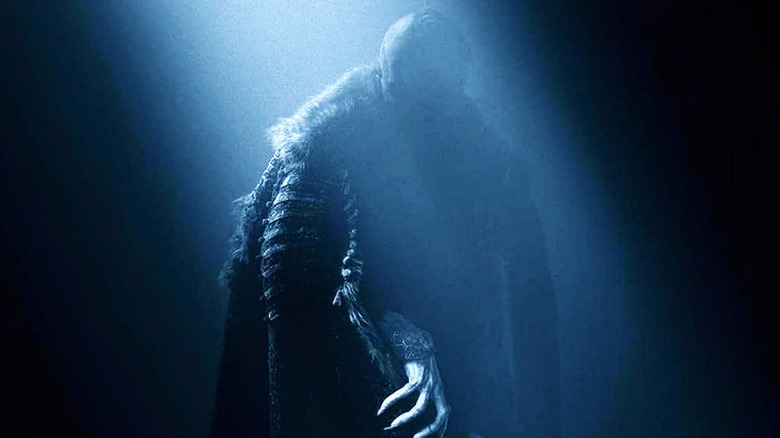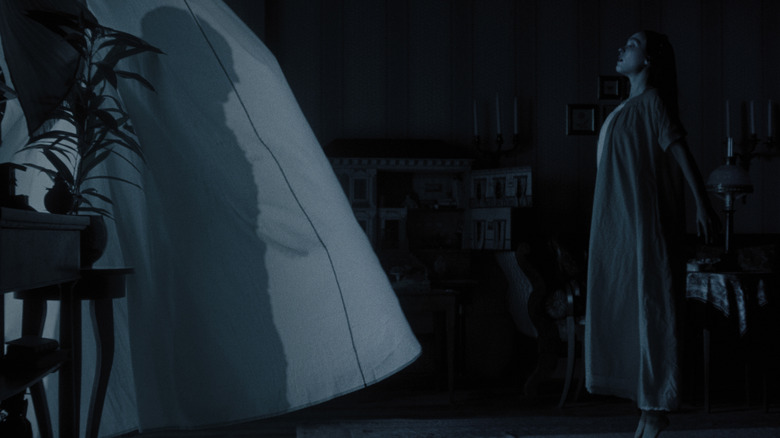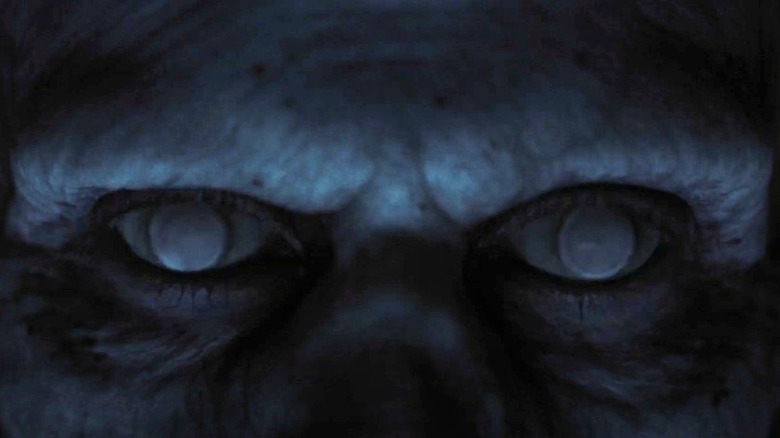
Focus Features
With the arrival of Robert Eggers' "Nosferatu," we can say one thing for certain: Bill Skarsgård is really good at stepping into the roles of iconic horror movie monsters. Skarsgård has seemingly pulled off this minor miracle twice, with stunning results both times. In 2017's "It," Skarsgård slathered on some greasepaint to play Pennywise the Dancing Clown (a role he's reprising in the upcoming Max series "Welcome to Derry"), the malevolent shape-shifter prone to hanging out in sewers and chowing down on kids. It was no small feat. While 2017's "It" was the first feature adaptation of Stephen King's tome of terror, it wasn't the first time the material had made it to the screen. Back in 1990, "It" was adapted into a TV miniseries, and featured the legendary Tim Curry as Pennywise. When word broke that "It" was being adapted again, fans of the miniseries all seemed to share the opinion: it would be nearly impossible for anyone to step into Curry's clown shoes. Curry's take on Pennywise had become so legendary, so ingrained into pop culture, that it was seen as a fool's errand to even try to replace him.
And yet, Skarsgård pulled it off. I'm not going to sit here and debate which of the performances is "better," simply because they're both unique and distinct from each other. Curry's Pennywise feels like more of a carnival showman; a big, loud trickster who seems to really enjoy his work. Skarsgård's take, in sharp contrast, is a lot weirder; he pitches his voice up, crosses one of his eyes (something the actor is able to do for real, without the aid of makeup or CGI), and drools a lot. Skarsgård's Pennywise is almost childlike in certain ways; he seems immature, even though he's apparently been around for centuries. And in the end, Skarsgård made it work. It might simply be a case of recency bias, but these days, if you ask someone to picture Pennywise, they're almost certain to think of Skarsgård's version first. It's proof that the doubters were wrong, and that Skarsgård really had what it took to make a horror icon his own.
Now, with "Nosferatu," he's done it again. You could argue that by taking on the role of Count Orlok, Skarsgård had an even bigger challenge than playing Pennywise. With Pennywise, the actor only had to contend with the memorable performance of one person, Tim Curry. WIth Orlok, Skarsgård has to deal with multiple actors having played the role already. In 1922, Max Schreck, looking completely believable as a rodent-like vampire, originated the character in F. W. Murnau's silent classic. Then, in 1979, legendary and problematic actor Klaus Kinski played the vampire for Werner Herzog's remake "Nosferatu the Vampyre" (note: Kinski's character is named Count Dracula in Herzog's film, since "Nosferatu" was an officially "Dracula" adaptation, but Kinski is clearly playing the same Orlok character, complete with similar makeup). And just to complicate things further, the wonderfully meta horror film "Shadow of the Vampire" had Willem Dafoe slip into the famous Orlok makeup to play a (fictionalized) version of Max Schreck (interestingly enough, Dafoe appears in the new "Nosferatu," too, playing a vampire hunter). That's a lineup of heavy-hitters. And yet, despite the odds, Skarsgård makes Count Orlok his own, just like he did with Pennywise.
Bill Skarsgård's Count Orlok looks different than previous versions

Focus Features
While Robert Eggers' "Nosferatu" is more or less following the same story beats as the original film (and countless other "Dracula" movies), Skarsgård's Orlok makes an impact because he's a much different monster than what we're used to seeing. Rather than recreate the memorable makeup that Max Schreck wore in the original film (and that Herzog repurposed for his remake), Eggers' film presents a much different looking Orlok. Marketing material has gone to great lengths to keep Orlok's new look a secret, so I won't give too much away here. But in creating his vampire, Eggers wanted to change things up. Whereas the other Orloks look monstrous and inhuman, with rat-like fangs and pointy ears, Skarsgård's Orlok looks like a walking, talking corpse — his skin is waxy, his limbs are decayed, his eyes have sunk back into his skull. He truly looks like a dead body that has somehow come to life.
"When I saw the first [makeup] moulds, where they had used my face cast and built on top of it, I was like, 'OK, well, this looks absolutely nothing like me,'" Skarsgård said during a conversation with Eggers for Another Magazine. "Not only is he a dead corpse, he also never looked anything like me when he was alive. I was terrified — I didn't know if I could bring life into this, if I could carry this face on top of mine, if I could make it feel real. Once we had the first make-up test and they put all the pieces on, but before they painted it in and put on the wigs – the last touches – I looked like a goblin. I was looking at myself in the mirror like, this is terrible, this is terrible."
Eggers struck on the idea of casting Skarsgård after seeing the actor play the human incarnation of Pennywise in the sequel "It: Chapter Two." He also realized that while Orlok is ugly, the actor playing him should be, well, hot. As Eggers put it, "[F]or Orlok to be a corpse, and for the romance to still work, it would be helpful for the audience to know that there is someone young and beautiful under there." Even though he frequently plays grotesque characters, it's obvious that Skarsgård is a really good looking guy, and Eggers wanted to find a way to exploit that while also making his Orlok repulsive. "Bill's so tall and so skinny, which is perfect for the physicality I was looking for," the director said.
Bill Skarsgård's Count Orlok voice is incredible (and scary)

Focus Features
Makeup is a big part of Orlok, but there's more to the role than his looks (and truth be told, Eggers and cinematographer Jarin Blaschke go to great lengths to keep Orlok mostly in the shadows, so we never really get a great look at him). The key ingredient to making the new Count Orlok unique is in how Skarsgård plays him. Through his physical performance, the actor is able to make Orlok seem ancient. We can practically smell the grave dirt on his cloak. Skarsgård disappears into the role; we never once see him in the character; we simply see Count Orlok, this very old, very dead thing that feeds on blood.
The element that ties all of this together is Skarsgård's vocal work. The complete opposite of the high-pitched voice he used for Pennywise, Orlok's voice in "Nosferatu" is deep and guttural. The actor lowers his voice a whole octave, and his words rumble and roll like waves in a stormy sea. "I locked myself into this haunted hotel room and was kind of going insane, which I needed," the actor said of his preparation to find Orlok's voice. "I would walk along this corridor, trying to get my voice as deep as I possibly could. I think I have 500 voice recordings."
I saw "Nosferatu" in a Dolby screening room, which greatly enhanced the effect. When Skarsgård first unleashes his strange, deep, scary Orlok voice, the sound system made my ribcage rattle. It had an actual physical effect, and shocked me. I know what Skarsgård sounds like in real life, and this does not sound like him at all. All of these elements swirl together to create a complete transformation. I doubt Skarsgård wants to get typecast as the guy who plays new versions of classic monsters, but the fact that he was able to do just that so successfully not once, but twice, is truly remarkable.
"Nosferatu" is now in theaters.







:quality(85):upscale()/2025/01/14/931/n/1922564/0dc333a96786d52b2c80c7.95468346_.jpg)

 English (US) ·
English (US) ·